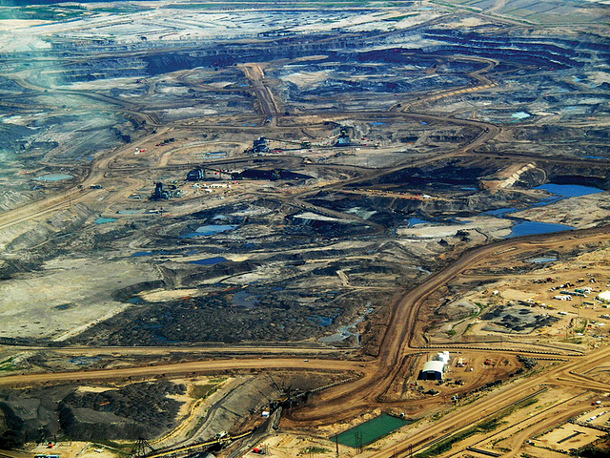On any hot day Shell and Syncrude tour guides used to call the gasoline-like vapours that wafted from Fort McMurray's huge open-pit bitumen mines "the smell of money."
But a new study in Nature has another name for the stench: air pollution and megacity volumes of it.
In fact the tarsands, already the largest source of climate disrupting greenhouse gas emissions in Canada, have a new grim moniker: "one of the largest sources of anthropogenic secondary organic aerosols in North America."
Researchers define "secondary organic aerosols" or SOAs as gases and particles that interact with sunlight in complex ways and that are released by both the globe's plant matter as well as fossil-burning machines and industries.
That mining the oilsands would create smog isn't news to researchers -- but the kind of air pollution identified and the sheer magnitude of it is what startles, and concerns, the scientific community.
Pollution from bitumen mines is composed of hydrocarbons similar to those spewed from cars and trucks, explained Environment Canada researcher John Liggio, and the study's lead author.
The vapours react with sunlight and form particles in the air. "They are larger molecules than the hydrocarbons that would be emitted from a city. These vapours react in the atmosphere to form secondary organic aeorsols, which is part of smog."
SOAS have been linked to a variety of bad health impacts including respiratory and cardiovascular diseases.
Pollution from industrial bitumen operations pulsates into the atmosphere at the rate of 55 to 101 tonnes a day. Scientists aren't sure if the pollution is coming from mine sites, upgraders, or 220 square kilometres of lakes containing mining waste -- or all three.
Environment Canada scientists taken aback
Bitumen's poor quality compared to conventional oil accounts for extreme volume of smog-like pollutants. Bitumen, a mixture of water, sand, clay and bacteria-degraded heavy tar-like oil, is so carbon rich and hydrogen poor that it must be upgraded into a usable fuel.
Everyday industry now extracts, upgrades and processes about 2.4 million barrels of bitumen.
The scale even surprised researchers at Environment Canada because that sort of pollution from SOAs is normally associated with large cities.
But air pollution from the oilsands, measured by airplanes, is now "comparable to downwind of megacities such as Mexico City and Paris, and is higher than that observed in Tokyo and New England."
The tarsands even outdo the pollution drifting from the Greater Toronto Area at 67 tonnes a day.
Moreover the absolute rate of daily air pollution is comparable to the noxious vapours that evaporated during BP's 5-million-barrel oil spill at Deepwater Horizon in the Gulf of Mexico in 2010.
The Nature study noted that conventional fossil fuels don't release as many SOAs as lower quality heavy oil or bitumen. Unconventional or extreme oil, some of the world's costliest and most dirty oil, now accounts for 10 percent of the globe's annual petroleum extraction.
"In light of the current trend for increasing heavy oil production relative to conventional crude, further investigation is required to fully understand the magnitude of this potential global issue."
Mysterious pollutants
Scientists don't know a lot about SOAS. They don't know their most common sources or their complete chemical composition. Nor do they know what happens to the pollution as it travels through the atmosphere or even what impact it may have on climate change.
Toxic vapours from bitumen storage and venting tanks near oilsands operations in Peace River have sickened residents for years and forced many to flee the province.
The new federal study follows another damning scientific report three years ago. That federal study confirmed what a discredited industry-funded monitoring program could not: that pollution has now contaminated lakes as far as 90 kilometres away from the massive mining project.
Due to "the absence of well-executed environmental monitoring in the Athabasca oilsands," Environment Canada researchers cored the sediment of six lakes ranging from 35 kilometres to 90 kilometres away from the project.
In the sediment of boreal lakes researchers discovered that airborne pollutants from the tarsands production were now two to 23 times greater than levels deposited in the 1960s.
The study showed, contrary to pro-tarsands industry and government propaganda, that bitumen pollution "is not natural, is increasing over time and the footprint of the industry is much bigger than anyone thought," said John Smol, one of Canada's leading freshwater ecologists, a Queen's University professor and a contributor to the study.
Largest greenhouse gas emitter
At the same time, the tarsands remain the largest single source of greenhouse gases in the country. Environment Canada reported this year that the nation's oil and gas sector was the largest greenhouse gas emitter in Canada and accounted for 192 megatonnes or 26 per cent of the nation's total emissions.
The country's sprawling transportation sector came second with 171 megatonnes or 23 per cent of emissions.
According to Environment Canada, climate disruptive pollution from the tarsands could increase by 124 per cent (64 megatonnes) between 2010 and 2030 and reach about 115 megatonnes.
Earlier this year the Conference Board of Canada gave the country a "D" for its poor environmental performance. Only two other countries ranked worse: the United States and Australia. In particular the board described the performance of Alberta and Saskatchewan, two heavy oil producers, as "dismal" on air pollution and climate change. ![]()
Read more: Energy, Environment

















Tyee Commenting Guidelines
Comments that violate guidelines risk being deleted, and violations may result in a temporary or permanent user ban. Maintain the spirit of good conversation to stay in the discussion.
*Please note The Tyee is not a forum for spreading misinformation about COVID-19, denying its existence or minimizing its risk to public health.
Do:
Do not: